三葉虫
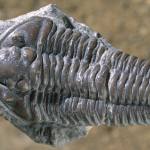

Calymene blumenbachii, Silurian, Englandはダドリーローカス、ダドリーバグまたはダドリー昆虫として知られているようになりました。 CalymeneはDudleyの紋章の中心に描かれています。 BGS ©UKRI.

三葉虫は初期の動物の中で最も重要であると位置づけられています。 三葉虫の化石は、堆積物の中に埋まって岩石になった後の殻の印象が残っています。 カンブリア紀の初期に突然出現し、カンブリア紀からオルドビス紀初期の海を支配するようになった。 その後、長期の衰退を経て、約2億5000万年前のペルム紀末に絶滅した。
- The animal
- Environment
- The geologists’ tool
- Fun facts
- 3D fossil models
The animal
Trilobites were arthropods (they belonged to the phylum Arthropoda) — like many invertebrate animals living today, including crustaceans, spiders and insects. Geologists know that they were marine animals because of the rocks in which they are found and the other types of fossils associated with them.
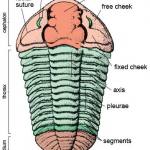

Parts of a trilobite exoskeleton. BGS ©UKRI. All rights reserved.

For support and protection, the soft parts of the trilobite animal were covered by an exoskeleton. Usually only the dorsal part of the exoskeleton, covering the animal’s back, was fossilised.
外骨格は、前方から後方に向かって、頭盾(セファロンと呼ばれる)、胸部、尾部(ピギディウムと呼ばれる)に分かれています。 また、左右に分かれており、中心軸と、胸膜と呼ばれる2つの側面の領域(または葉)がある。 三葉虫という言葉は、頭部、胸部、尾部ではなく、横から横への仕切りを指す。 頭骨、胸骨、脛骨はすべて節に分かれている。 生前は頭骨と脛骨の節は融合していたが、胸部の節は融合していなかったため、危険な時には丸くなって比較的露出した腹側を保護することができた。
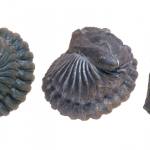

シルリアン時代のカリメンの標本です。 カリメンは丸めて身を守ることができた。 BGS ©UKRI.

頭蓋骨の中央部は口蓋と呼ばれ、口蓋の中央部は掌底と呼ばれます。 グラベラの両側にある頬は、通常、顔面縫合線によってグラベラに隣接する固定頬と頭骨外縁の自由頬に分けられる。 この縫合により、成長期に脱皮しやすくなっている。 脱皮の際、三葉虫の外骨格はしばしば粉々になり、そのため化石は通常、断片として発見される。
ほとんどの三葉虫は目を持っていましたが、盲目のものも知られています。 目は自由な頬の内側の端にあり、固定された頬に隣接しています。 三葉虫の目は複眼で、いくつものレンズから構成されていました。 レンズの数や目の構造の複雑さは千差万別である。 ある三葉虫は、大きな凸型の複眼(ハエのような)を持ち、多数のレンズがあるため、実際の曲率にもよるが、前後左右、上方、あるいは下方まで広い視野を持つことができた。 他の三葉虫の目はもっと小さく、レンズの数も少ないので、視野が狭くなる。 多くの三葉虫の目は、方解石のプリズムが密集しただけのものだったが、シルル紀からデボン紀のファコプス属のような、より複雑なレンズを持つものもあった。 ファコプスはこのレンズを使って、物体をはっきりと見ることができ、それがどのくらい遠くにあるのかを推定することもできたかもしれない。
三葉虫が持っていたその他の感覚器官には、外骨格の表面にある孔、管、結節、棘などがあります。
柔らかい部分は、ラーゲルシュテッテンで特殊な状況下で保存されている数種の三葉虫について知られています。
地質学者は、三葉虫が頭骨の下から前方に突き出た一対の関節触角と、体の両側に関節のある四肢の列を持っていたことを知っています。 三葉虫は頭骨の下に3対の肢を持ち、胸部と脛骨の各節の下に1対の肢を持つ。 各肢には2本の枝があり、下枝は歩行に使用され、上枝には呼吸に使用されたと思われる多数の細いフィラメントがある。
環境
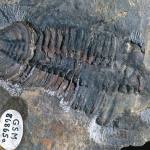

Neseuretus, Ordovician, England, Shropshire x 0.6……。 BGS ©UKRI.

特定の三葉虫が海の特定の深さに住んでいたという証拠がいくつかあり、古環境の指標として利用することが可能です。 Neseuretusは非常に浅い水深の堆積物に関連する属の例であり、一方Whittardolithusのような三葉虫は深い海底に住んでいたと考えられている。
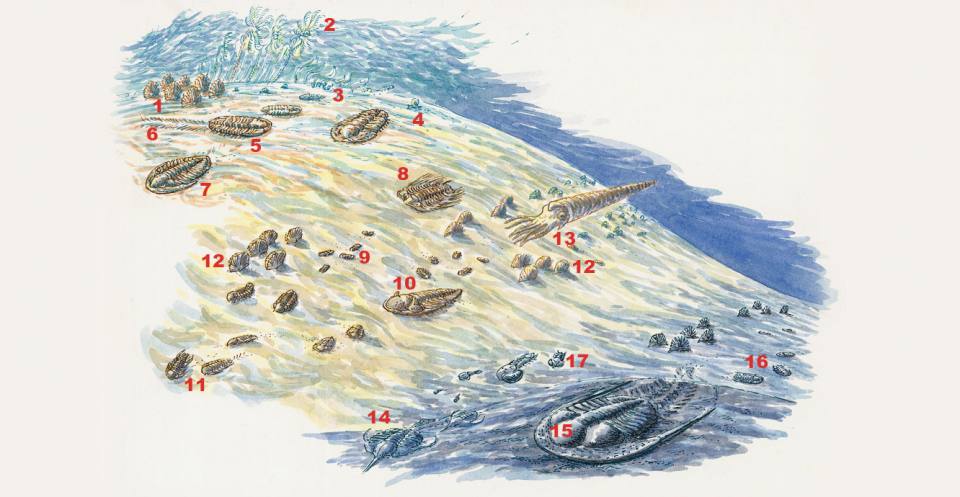

Lifestyles of trilobites: the painting shows how trilobites from different periods lived in the sea. In shallow waters amongst the bivalves (1), crinoids (2), algae (3) and gastropods (4), the faunas were large, but of low diversity, e.g. Flexicalymene (5). Intermediate faunas were more diverse— Selenopeltis (8), Geragnostus (9), Chasmops (10) and Remopleurides (11) lived alongside brachiopods (12) and nautiloids (13). In the depths of the sea, the trilobites were small and blind with moderate diversity— Ampyx (14), Tretaspis (15) and Shumardia (16), with Pricyclopyge (17) swimming above. BGS ©UKRI. All rights reserved. (Painting by Richard Bell)

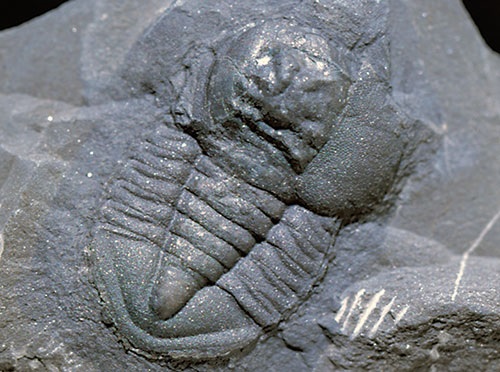

Pricyclopyge, a trilobite with large eyes and all round vision which probably swam rather than crawling on the sea floor. (x2.5). BGS ©UKRI. All rights reserved.

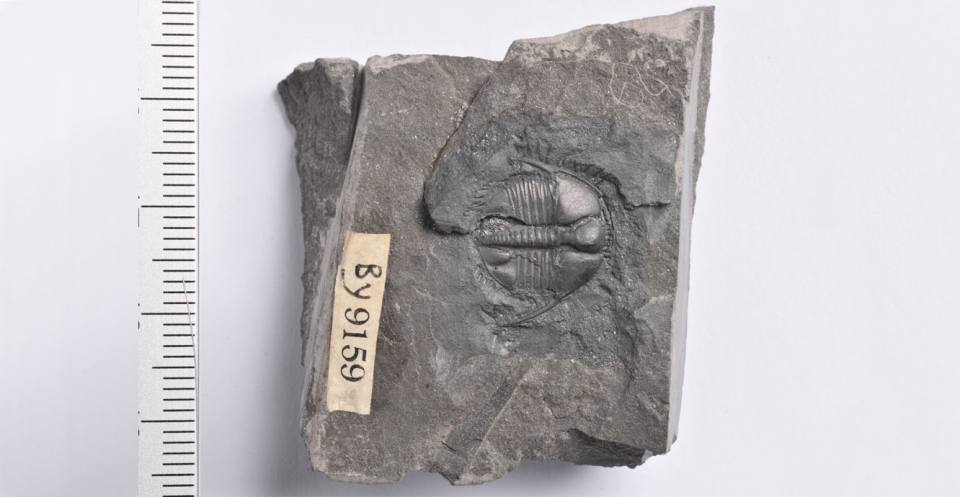

Trinucleus, a trilobite with no eyes, which lived in mud or at great depths. It had spines for support, and a fringe with pits, possibly for sensory organs. (x3). BGS ©UKRI. All rights reserved.

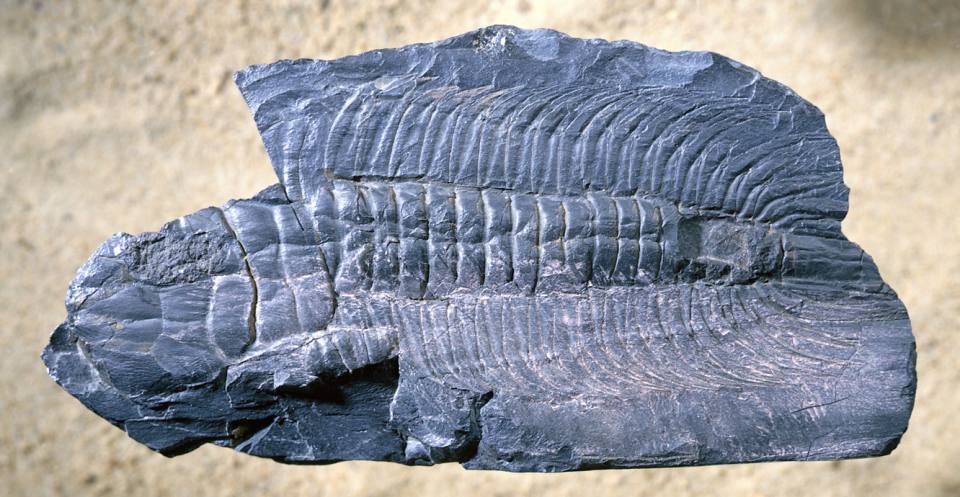

Paradoxides, one of the giants of the trilobite world. This specimen, though incomplete, is 12 cm long. BGS ©UKRI. All rights reserved.

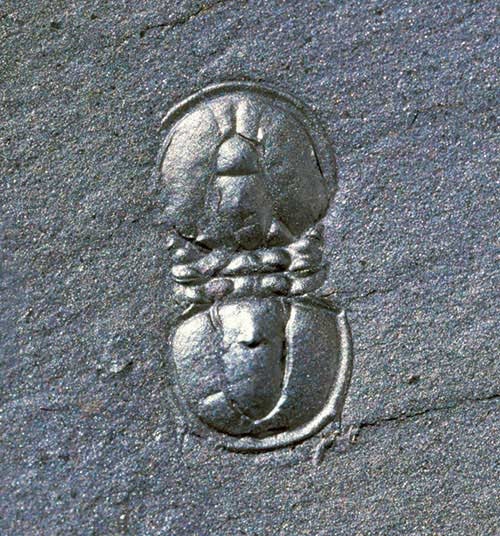

一方、この小さな三葉虫は体長5ミリメートルです。 アグノスティッド三葉虫は本当に三葉虫なのか、疑問視する声もある。 BGS ©UKRI.

体の形や大きさが非常に多様であることは、三葉虫がさまざまな生態的ニッチを占めていたことを表しています。 盲目の三葉虫は、海底の泥の中に潜り込んで漁をしたり、光のない海中のかなり深いところで生活していたのかもしれない。 また、他の三葉虫は、海底を移動し、他の動物を捕食していたことを示す、敷設面上の痕跡を伴っている(例:Cruziana)。 これらの三葉虫は底生動物の一部であった。 さらに、サイクロピゲのような三葉虫は、大きな目を持っており、下も他の方向も見ることができた。 そのため、地質学者は三葉虫が海底を泳いでいた、あるいは浮いていたと考えている。
地質学者の道具
三葉虫の時代:カンブリア紀に出現し、ペルム紀の終わりに絶滅しました。 イギリスでは、ウェールズやウェールズ国境地帯などのカンブリア紀、オルドビス紀、シルル紀の岩石、イングランド南西部のデボン紀の岩石、ランカシャーなどの石炭紀の岩石で三葉虫が生息しているそうです。
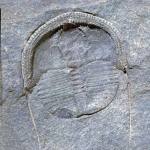

Whittardolithus x 1.5. BGS ©UKRI.
地質学者は三葉虫をさまざまな方法で利用して、地球がどのように発展してきたかを理解するのに役立っています。 特にカンブリア紀やオルドビス紀初期の堆積岩の相対年代測定や層序相関に利用されています。 三葉虫はカンブリア紀の岩石を相関させるのに特に重要である。 例えば、パラドキシドはイングランド、ウェールズ、ニューファンドランド、スウェーデン、スペイン、シベリアの岩石で産出し、これらの岩石がすべて同じカンブリア紀中期のものであることを示している。
地質学における三葉虫のもうひとつの用途は、過去の地理(古地理)と過去の環境(古環境)を復元することです。 オルドビス紀初期の三葉虫Petigurusは、北米で発見されたものの、スコットランドの北西部で発見され、英国の他の地域では発見されていません。 イングランドとウェールズの初期オルドビス紀三葉虫(Placopariaなど)は、北米のものと異なり、フランス、スペイン、ポルトガル、ボヘミア、北アフリカでも見つかっている。 This is part of the evidence showing that much of Scotland was close to North America about 500 million years ago, and was separated from southern Britain by an ocean that has been named Iapetus.
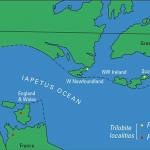

A continental reconstruction around 500 million years ago using today’s geographical outlines. The Iapetus Ocean, which separates the trilobite provinces, closed in the Silurian and the resulting collision between North America and Europe produced the Caledonian mountains. BGS ©UKRI. All rights reserved.
Fun facts
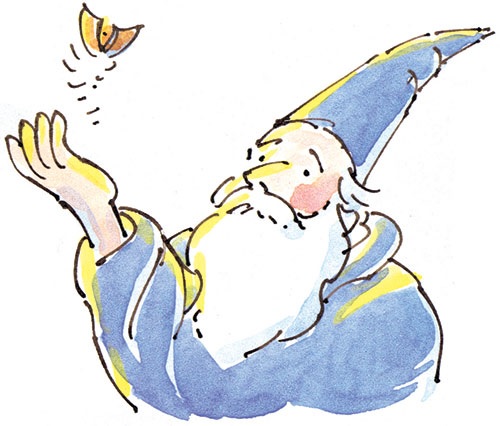

In south Wales, around Carmarthen, the tails (pygidia) of some early Ordovician trilobites are so conspicuous that they were referred to locally as ‘petrified butterflies’, and were associated with legends concerning the magician Merlin.

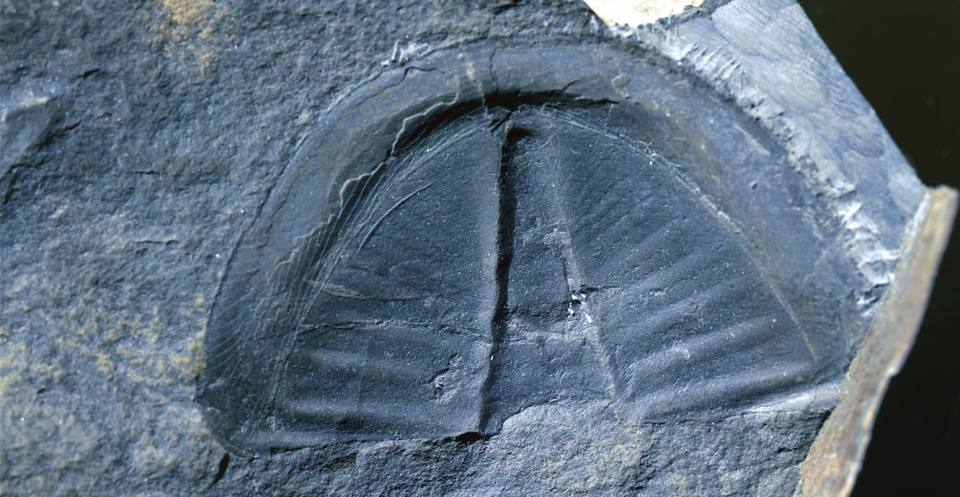

Merlin the magician even has a trilobite from this area named after him — Merlinia. Elsewhere, there are associations between trilobite tails and butterflies or bats, for example in the Swedish fjärilssten and the Chinese Hu-die-shih, both meaning butterfly stone, and the Chinese Bien-fu-shih, meaning bat stone. BGS ©UKRI. All rights reserved.

3D fossil models
Many of the fossils in the BGS palaeontology collections are available to view and download as 3D models. この化石や他の化石を 3D で見るには、GB3D Type Fossils をご覧ください。